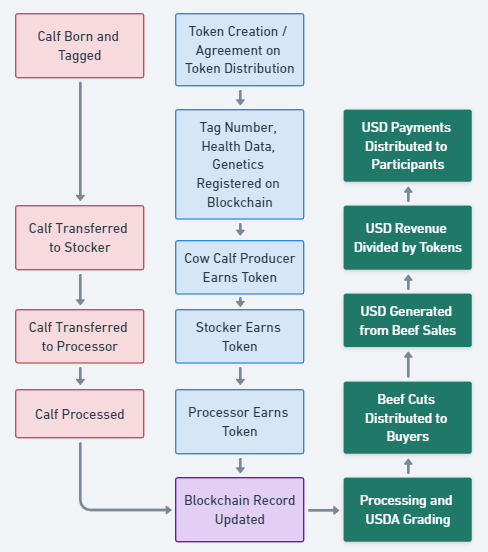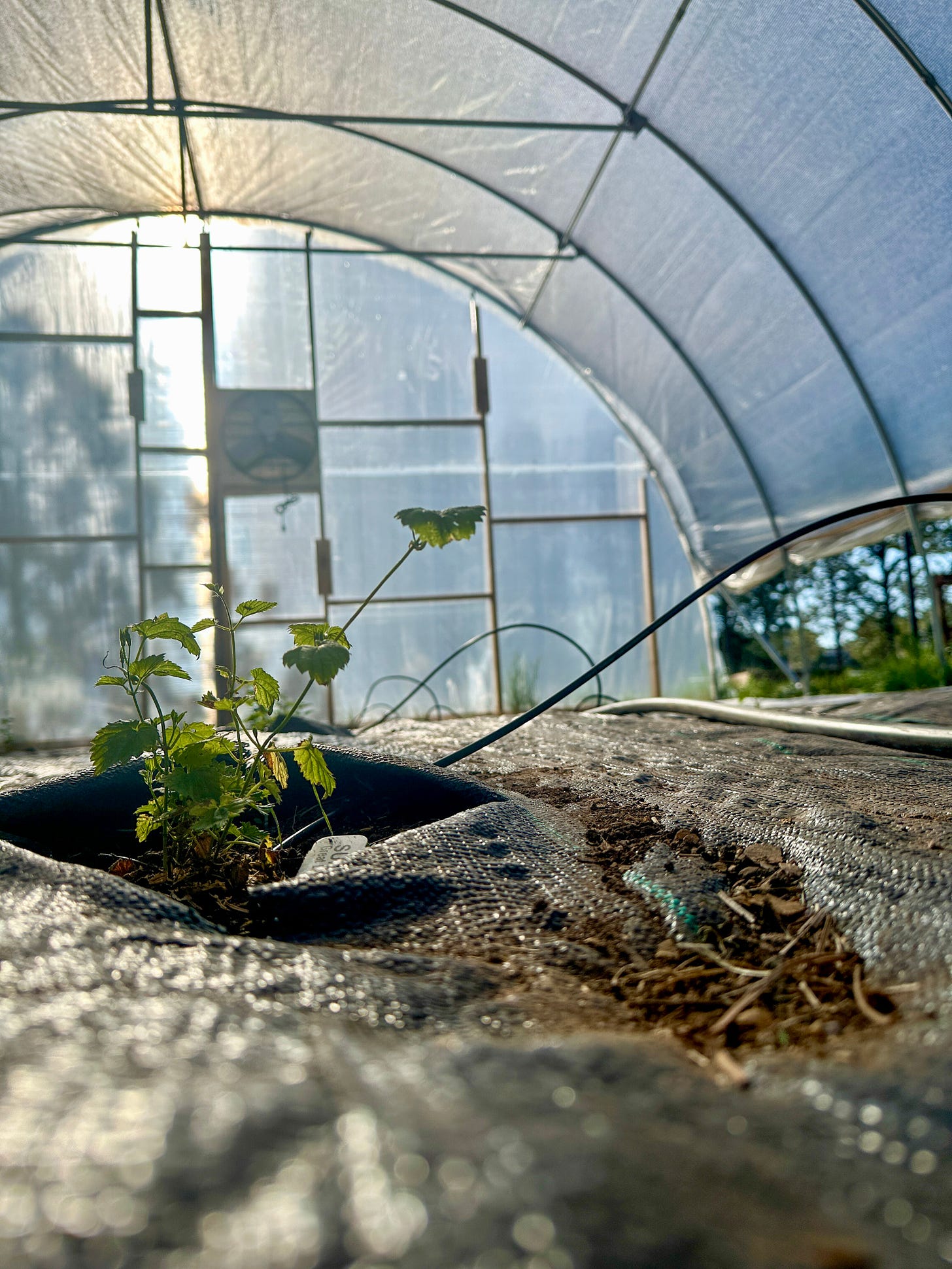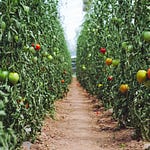Let’s begin the process of registering an agricultural product on a blockchain as a capability demonstration for agricultural cooperatives!
Let’s pick up where we left off with agricultural blockchain cooperatives by addressing a couple of listener questions.
1. With this blockchain partnership, how does the rancher or farmer expect to be paid?
The rancher needs to be paid in US dollars. While cryptocurrency is a form of payment, ranchers and farmers run their operations in dollars. The blockchain tokens do have a value, but their role in the agricultural cooperative is verification of quality and traceability, not payment. The tokens also automate the amount of payment that goes to each rancher in the cooperative based on the number held by each rancher.
This system's advantages include transparency. Each transaction and token exchange is recorded on the blockchain, providing a clear history of ownership, responsibility, and quality. Further, payments are automated and distributed based on the smart contracts, significantly reducing administrative overhead and the potential for human error.
Ranching and Blockchain Pathways Separate from US Dollar Payments
In the diagram above, agricultural operations are colored in red. These steps cover the physical handling of cattle from birth through different phases of growth and finally to processing.
Blockchain operations are shaded in blue. These include the creation of tokens and registering detailed data such as tag numbers, health data, and genetics on the blockchain. Tokens are awarded as cattle progress through various stages, attributing a digital value to the efforts of each contributor.
US dollar payment operations are shaded in green. After the beef is processed and sold, the revenue generated is distributed among participants based on the tokens they hold. Using tokens as a measure of contribution ensures that each participant is fairly compensated according to their role in the value chain. This arrangement links the blockchain-tracked contributions directly to financial rewards.
Agricultural and blockchain operations run concurrently. Once both operations conclude and the beef is sold to buyers, producers receive payment in US dollars.
This hybrid model leverages the strengths of blockchain for data integrity and traceability while maintaining the usability of conventional currency systems for easy commerce and trade.
2. And a follow-up question: don’t the tokens cost money to acquire and use?
Yes, blockchain tokens do have a monetary cost.
For some examples, one Bitcoin (BTC) token is around $67,000 USD, one Ethereum (ETH) token is approximately $3,800 USD, one Solana (SOL) token is approximately $170, one Polkadot (DOT) token is approximately $7 USD, and one Cardano (ADA) token is around fifty cents.
Further, different blockchain systems offer different capabilities.
Bitcoin is primarily used for monetary transactions and as a long-term store of value. Its network is robust and secure, though it lacks the flexibility for complex smart contracts. Because of this, it would not be a good choice as an agricultural cooperative token.
Ethereum offers comprehensive smart contract functionality that supports a wide range of decentralized applications, making it foundational in decentralized finance (DeFi). If a producer found the cost acceptable, it would be a good choice for an agricultural cooperative. Ethereum's capabilities would allow for detailed tracking, verifiable traceability of produce, and automated financial distributions, making it a strong candidate if the cooperative can manage the associated costs.
Solana is an Ethereum competitor. It offers fast transaction speeds and lower costs, making it ideal for high-frequency trading and decentralized applications that require rapid state changes. Solana supports smart contracts and decentralized applications, making it a viable choice for agricultural cooperatives that prioritize speed and efficiency.
Polkadot supports the use of several token types across various blockchains through a central relay chain. For agricultural cooperatives, Polkadot allows for the customization of blockchain features to suit specific needs like supply chain management and financial transactions. Polkadot's scalable architecture ensures that as a cooperative grows, the system can handle increased transaction volumes efficiently. Each Polkadot parachain can process transactions independently, transferring any type of data or asset across chains, aiming to solve scalability issues that currently affect Ethereum.
Cardano is another Ethereum competitor. It offers advanced security and sustainability features, aiming to provide more advanced and efficient smart contract capabilities. Cardano supports smart contracts and decentralized applications.
You can start to see the benefits and disadvantages of each blockchain type. Polkadot seems to be a good place to start because of its customization ability and reasonable cost. But because of its advanced security features and low fees, let’s not rule out Cardano for a cooperative concerned with data integrity.
If we are going to register an agricultural product on a blockchain as a capability demonstration, we need an agricultural product. And we are in luck, as I happen to have some hop plants to use for the capability demonstration.
About Hops
Hops are the flowers of the hop plant Humulus lupulus. They are used primarily to bitter and flavor beer while imparting floral, fruity, or citrus flavors and aromas. Brewers add hops to beer to balance the sweetness of the malt and contribute additional flavors and aromas. The hop plant is a vigorous, viney, climbing, herbaceous perennial. Hops growers train the hops to grow up strings or on horizontal trellises.
The first written use of hops in brewing was recorded in the 9th century. Traditionally, hops were grown in regions of Germany, the Czech Republic, and England, but now the United States, particularly the Pacific Northwest, has become a major hop-producing area.
Strong winds are detrimental to growing hops (and really any plant). Wyoming is known for strong winds. To protect my hops, I'm growing them in a greenhouse structure. The planting date was May 17, 2024. The plants get water from a custom-built drip water system.
I’m growing three varieties of hops: Cascade, Chinook, and Super Alpha. Each has different characteristics.
Cascade Hops
Cascade hops are one of the most popular hop varieties in craft and home brewing. They are known for their distinct floral, citrus, and grapefruit character. Originating in Oregon in the 1950s, Cascade was the first commercially successful American hop variety that came from the USDA breeding program. Cascade hops are used in a wide range of beer styles, particularly American Pale Ales and India Pale Ales.
Chinook Hops
Chinook hops were developed in Washington State and released in 1985. Known for their piney, spicy bouquet, and robust flavor, they are often used in the brewing of American-style Pale Ales, IPAs, and Stouts. Chinook hops are excellent for adding considerable bitterness. Their distinct aroma profile allows them to be used as a late addition to the boil or in dry hopping to enhance the beer’s aroma.
Super Alpha Hops
Super Alpha is a New Zealand hop variety developed in the 1970s. It is noted for its clean bittering properties and a complex mix of lemongrass, pine, and herbal notes. Super Alpha hops are particularly well-suited for Lagers, Pale Ales, and IPAs where a clean, sharp bitterness is desired. Their vibrant, aromatic lift complements other ingredients.
Each of these hop varieties brings a unique set of characteristics to the brewing process. They allow brewers to experiment with a range of flavors and aromas to create distinct and memorable beers.
This hops environment supports plant health and offers a consistent framework for our blockchain experiment.
Future Episodes
In future episodes, we will:
Set up the blockchain environment and begin the registration process for each hop variety.
Openly discuss the successes and failures of the blockchain and the growing process.
Discuss the specific blockchain platform chosen for this demonstration and rationale.
Integrate real-time data from our hops into the blockchain for live tracking and management.
The capability demonstration's intent is to understand how we can practically apply blockchain innovation to enhance agricultural practices and cooperative management.
Stay tuned!
May God bless the United States of America.

















An Introduction to Registering Hops on the Blockchain and Listener Questions